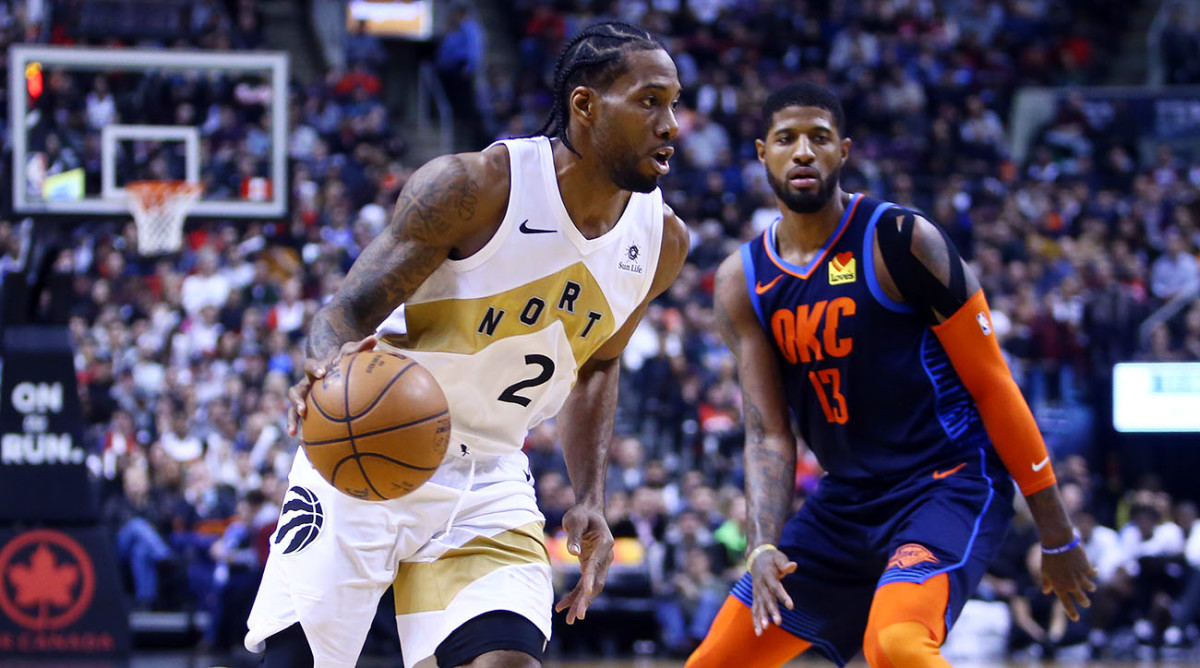NBA Stars Have More Power Than Ever, But How Well Are They Using It?

As the dust settled in the wake of the Russell Westbrook trade late last week, it became clear that among several factors compelling Houston to act, James Harden's preferences were likely high on the list. Harden is a perennial MVP candidate, he's the star who guarantees the Rockets will be relevant every season, and he's also the star who allegedly had problems with Chris Paul. In May, after Game 6 and the end of this year's Rockets-Warriors series, Paul left the arena almost immediately. Harden met with reporters and told them that he knew exactly what the Rockets needed to do this summer.
Last week, while plenty of outsiders wondered about the fit between Harden and Westbrook, ESPN reported that Harden called Daryl Morey on the day of the trade and told him not to worry. In the end, Houston made the deal.
Teams doing what superstars want has been a theme of the NBA summer. In Los Angeles, the Lakers and Clippers traded a combined eight first-round picks and four pick swaps in the 2020s, not to mention former lottery picks Shai Gilgeous-Alexander, Lonzo Ball, Brandon Ingram. The teams agreed to those deals because a) LeBron James wanted to finish his career next to Anthony Davis and the Lakers couldn't afford to miss on that opportunity, and b) Kawhi Leonard wanted to sign with the Clippers but refused to commit to them without another superstar already in place.
Nobody needs me to be the 10,000th NBA writer to point out that today's stars have more leverage than ever and aren't afraid to use it. What became interesting this summer, though, is how amazingly transparent it all became. Would-be title contenders weren't simply asked to cater to stars, but to mortgage long-term flexibility and make decisions that would be considered irresponsible in almost any other context. The Clippers were the most extreme example; they traded a star lottery pick (Shai Gilgeous-Alexander), a playoff-caliber starter (Danilo Gallinari), two pick swaps, and five first-round picks for Paul George, a 29-year-old who is currently recovering from surgery to both his shoulders.
If the George deal happened this coming February, it would have been considered one of the most incredible overpays in NBA history. In July, the terms of the Clippers deal were met with league-wide shrugs. "You're not getting one player," a rival executive told SI of the Clippers' rationale. "You're getting both. If you don't do it? The guy you really wanted, he goes to... Well, I actually don't think he'd go to the Lakers. But there's a chance he goes to the Lakers. If you do it, you're getting both those guys. You have two really good two-way players on your team. They can guard the s--t out of the ball and they can score it. They're top five, top 10 players. I would start my team with those two and figure it out. Your odds are so much better now to win [a title]. It doesn't matter if you messed up the future in 2025."
That's all very true. But grading the Clippers deal on that curve assumes that Kawhi's trade-for-him-or-I-walk demand is a fixed element in the equation. If Kawhi wanted to be a Clipper, why are we so certain that it was a good idea for him to leverage his new team into a full blown godfather offer for George? What if, instead of using the Lakers threat to create a Clippers imperative, Kawhi had successfully convinced George to request a trade, but then signed with the Clippers before any OKC deal was consummated? Wouldn't Clips execs have had more leverage to deal with OKC? Couldn’t they have kept, say, two of those firsts to use in future deals and still easily beaten everyone on the market? Or in a broader sense: if you were betting on which model would have a better shot at yielding a sustainable title contender over the next four years, would you bet on Kawhi and 29-year-old Paul George, or Kawhi and whatever the Clippers front office could trade for five first-round picks, two pick swaps, Gallinari and Gilgeous-Alexander?
Again, the Clippers' situation isn't unique. Rather than wait out the Pelicans and risk unrest with LeBron, the Lakers traded a half-decade's worth of picks and pick swaps to make sure the Davis trade happened in June. Houston responded to rumored tension between Harden and Paul by exceeding what most outsiders expected of a Westbrook return and punting on a nucleus that, if Harden and Paul could have coexisted, still looked like one of the best playoff threats in the west.
In Brooklyn, once the Nets became the choice for Kyrie Irving and Kevin Durant, the team traded multiple first round picks to clear cap space and cut ties with a 23 year-old All-Star in D'Angelo Russell. Then the first order of business was ... signing 30 year-old DeAndre Jordan to a four-year, $40 million contract? That deal was a nod to longstanding friendship between Kyrie, KD, and Jordan, and it was a fun reminder that among his peers Jordan has always been one of the most universally beloved players in the entire NBA. It was also an amazing departure from the one-year, $4.4 million deal that Brooklyn had offered to Ed Davis to platoon with Jarret Allen a year ago.

I wonder how this summer's biggest decisions will age. It's become popular among media and hardcore NBA fans to declare that catering to stars is just how business is conducted these days. To think that it should be done any other way is to betray naivete. This is the new era, that logic argues. Superstars are the GMs now.
But is that dynamic healthy? I don't mean healthy for the league itself. There are plenty of other columns wrestling with what this summer's developments could mean for the two dozen or so teams that may never be able to attract free agent stars regardless of how much influence those franchises are willing to cede. What I wonder is whether the stars-as-GMs model is actually best for stars themselves and the teams that have the means to execute this plan.
We just lived through a decade in which coaches like Doc Rivers, Tom Thibodeau, and Stan Van Gundy tried their hand at balancing coaching and management responsibilities and failed in pretty decisive fashion. Each of them brought too much urgency to the offseason and repeatedly made decisions that handicapped their teams' long-term flexibility. Rivers, himself, admitted to making mistakes in his executive role in Los Angeles. "I always wanted to do all of it,” Rivers told the Washington Post in March. “[Team president was] a job that I wanted to do. I thought I could do it. But for me, it was a lot. For me, it was too much.”
Granted, a crucial difference between coaches-as-GMs and stars-as-GMs is that superstars have the credibility to recruit their peers and the means to do so without running afoul of any tampering rules. LeBron can take Anthony Davis to dinner after a Pelicans game and convince him that he belongs with the Lakers. Kawhi can meet with Paul George at a secret location in L.A. and convince him to request a trade to the Clippers. A superstar's ability to successfully do that legwork is an advantage over coaches and executives that really can't be overstated. Maybe that skill is all that matters in the end, as AD and George could be incredible enough to win a title and render a lot of process questions irrelevant. (Likewise on the process front: KD's reported-and-hilarious disgust at a one-for-one Russell sign-and-trade ultimately yielded the Nets a protected first-round pick).
Still, it bears mentioning that both stars and coaches approach team-building with a similar competitive urgency, and both groups are coming to any bargaining table with an outlook that's almost inevitably going to be blinkered by their own self-confidence. The same way Rivers once thought he could trade picks for trusted veterans and figure it out with Chris Paul and Blake Griffin, Kawhi probably isn't worried about pick swaps or assets to address point guard depth or the state of George's shoulder. LeBron isn't worried about sacrificing a few extra trade chips that could have afforded his team flexibility to add additional help 18 months from now. Harden isn't worried about whether the basketball fit with Westbrook will make next year's Rockets less effective in the playoffs than they might have been running it back with Paul.
Harden and Westbrook are friends off the court and they respect each other's talent. Of course Harden thinks they can make it work. Those are the same reasons Durant isn't worried about tying the rest of his prime to Kyrie or using Nets cap space to bring Jordan to Brooklyn.
This is a new era. The NBA's best players were far and away the league's most proactive architects this summer, and maybe that trend will continue in the years to come. But if the past few weeks have been the latest chapter in the story of superstar leverage in pro basketball, what's actually naive is to assume that the evolution will end here. Think back to LeBron on the Heat, LeBron in Cleveland, or KD in Golden State. The lessons and consequences of each iteration of player power are always a little more nuanced than we expect.
This summer’s stars have spent the past month using their power and influence more aggressively than ever, but now the question is how effective they’ve been. Over the next few seasons in L.A., Houston, Brooklyn and beyond, the NBA will get an answer.
